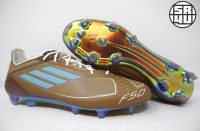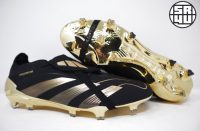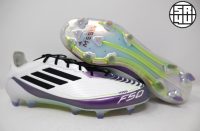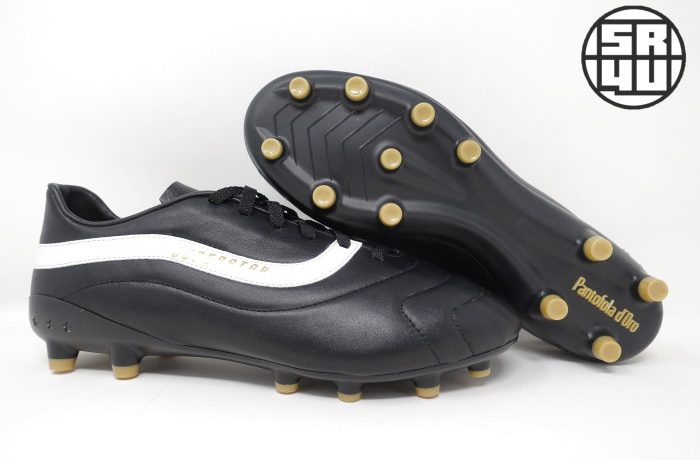The original Nitrocharge brought us an all-new silo from Adidas, introducing several new features and a combination of performance elements that really set it apart from every other boot on the market. One year later, and the 2nd generation Nitrocharge 1.0 is upon us, with a design that is visually quite different, but with very similar performance elements. Its responsive, lightweight and protective, a unique combination of characteristics that make the latest Nitrocharge 1.0 a very interesting option.
Comfort/Fit
Much like the original, the fit and feel of the Nitrocharge 1.0 is all about the forefoot EnergySling. Unlike the first Nitrocharge, the EnergySling now runs straight across the forefoot, as opposed to on a diagonal, and is also twice as wide. It still made from rubber, and still works with the lacing system, so you get an incredibly secure fit when you pull the laces tight. I also noticed that the EnergySling is also longer, so it provides a more complete wrap of the forefoot. Another new element to the EnergySling is the extra lace hole on the lateral side, which is there solely to aid in providing the most secure, locked down feel possible.
When you pull the laces tight, it is very evident what the EnergySling is all about. By locking your forefoot in place, you get a very responsive feel, meaning that the second you react, the boot will too. Since its made from a very strong rubber material, the forefoot area of the boot remains extremely stable, not allowing the upper to shift or stretch, keeping your foot directly on top of the outsole. The EnergySling is most impressive when making quick cuts and changes of direction, as its extremely responsive and stable.
In comparison to the original, this variation of the EnergySling, mainly because it’s wider, distributes the extra tightness in the forefoot a little more evenly. With that being said, it still takes some getting used to. I found that when I tied them up nice and tight, the shoes felt great, but after 10 to 20 minutes, I started to get some minor foot cramping/discomfort in the forefoot. The problem was easily fixed by simply loosening the laces ever so slightly, so it’s a matter of finding that sweet spot in order to achieve the most comfortable fit possible. Once you find that sweet spot though, the comfort level is great, and the responsiveness is even better.
The Nitrocharge 1.0 is 100% synthetic, and split up between three different materials. The front portion of the upper is made from HybridTouch synthetic, than you have the rubber EnergySling in the forefoot, and than protective mesh from the mid-foot back. As far as comfort is concerned, the different materials combine for a surprisingly comfortable fit and feel. You don’t feel any transition points when the shoes are on feet, and all of the materials are flexible enough to not cause any significant discomfort. Like many synthetic boots, there isn’t much of a break-in period, they’re comfortable from right out of the box. It’s more about getting used to how they feel.
Inside the boot, the bottom side of the upper is lined in a very smooth, soft material that covers up all of the seams and stitching that would normally be exposed. The heel is lined in a smooth synthetic leather material with a solid amount of padding, making for great step in comfort, and no heel slippage at all. The insole is fully removable, and unchanged from the original. It features a single layer of foam, and a synthetic suede lining, nothing special, but it gets the job done.
The Nitrocharge specific SprintFrame outsole and stud pattern also remains unchanged from the original. Based off of the SprintFrame outsole found on the F50 adizero, the Nitrocharge SprintFrame is a little more heavy duty, and also stiffer in comparison. In fact, the stiffness of the soleplate is marketed as a feature in the form of what Adidas calls EnergyPulse.
The EnergyPulse system plays into the “Engine of the Team” marketing that Adidas is pushing with this particular model. The EnrgyPulse is shown as a zig-zag pattern on the base of the forefoot, but it’s the entire soleplate that’s actually a different material. The idea is that the stiffer soleplate will make for some kind of energy return/feedback when springing back after being under tension. It sounds great, but the reality is that its more of a gimmick, rather than something that is going to have any significant impact on performance. Depending on the shoe that you’ve worn prior to the Nitrocharge, you will notice the extra stiffness at first, but like I mentioned, it isn’t stiff enough to make for any significant performance increase. These will not make you run faster, nor will they increase your endurance. The EnergyPulse system is an interesting concept, but a feature that should not be the deciding factor if you were considering a pair of Nitrocharges.
In terms of fit, the Nitrocharge is about average in width, with a more snug fit in the forefoot due to the EnergySling. The HybridTouch synthetic portion at the fronty of the boot will stretch a little after some wear-time, but the rubber EnergySling and protective mesh area of the boot will not stretch at all. All of this to say that the way they fit from out of the box is more or less the way they’ll fit for the entire lifespan of the boot. There still is some decent width to the shoe though, so as long as you don’t have excessively wide feet, and as long as you can tolerate a tighter fit in the forefoot, you should fit quite comfortably into the Nitrocharge 1.0.
As far as sizing is concerned, I had the opportunity to wear both an 8.5US and my usual size 9US for review. I found going half a size down was possible, and I was able to achieve a comfortable fit, but they were very tight. If you’re looking for an ultra-tight fit, going half size down is something to consider. With that said, I did feel most comfortable in my usual size 9US, and I do feel like the 2014 Nitrocharge does run true to size. So, if you’re looking to order a pair, I would recommend going for your normal size for the best possible fit.
Weight
Just like the original Nitrocharge 1.0, the latest model offers a very unique weight to protection ratio. In a size 9US, the Nitrocharge weighs in at 8.2oz, which is very similar to the first iteration, and still quite impressive. The tight fit, and solid construction in combination with the lightweight feel is a unique sensation, and a combination of features that is going to be particularly attractive to those who are looking for a boot that is going to provide above average protection, while not being too bulky or heavy. In my opinion, the Nitrocharge 1.0 is exactly the weight it should be.
Traction
As mentioned earlier, the latest Nitrocharge features the exact same soleplate and stud pattern as the original. You get the familiar triangular stud layout that we’ve seen on several different models in Adidas’ current and past line up.
You’ll find four triangular studs under the heel, with six more studs in the forefoot, three on each side and one single support stud in the middle. The triangular studs have a larger than average profile, so they offer great stability, but don’t penetrate the ground particularly well. The triangular shape is designed to provide a combination of characteristics from both conical and bladed studs, and I would say that this stud pattern provides that feel quite effectively. Its best suited for slightly softer, firm ground, natural grass playing surfaces, at least if you want optimal traction from this particular pattern, but as whole, it gets the job done.
One aspect of the boot that has a big impact on the traction of the boot is the EnergySling on the forefoot. The extra reinforcement in the upper and the locked down fit that it provides, makes the shoe feel extremely responsive. As soon as you push off and feel the studs dig in, the boot reacts, and that’s a great sensation. There is no rollover whatsoever, something that you just don’t get from pretty much any other boot out there. The stability of the boot in combination with the grip that it provides gives this boot a very agile feel, where you have the confidence to cut at high speeds, knowing that the boot is going to move with you, as opposed to falling behind.
I personally would have liked to have seen a new stud pattern to go along with the new upper design, but what you get definitely performs the part. While it isn’t my personal favorite stud pattern out there, it’s hard to deny that the traction experience that you get from the Nitrocharge is excellent.
Touch
When it comes to touch, the overall feel of the 2nd generation Nitrocharge 1.0 is not too far off from the original. While the upper design appears to be drastically different, it still combines the same three materials spread out across the entire upper. If I had a complaint the first time around, it would be that the upper lacks consistency when it comes to touch, meaning that using different parts of the foot to make touches on the ball will have a different feel. This is still the case with the 2014 edition, but the more streamlined design of the upper is what I would consider to be a small improvement.
At the very front of the upper, you’ll find a thin layer of HybridTouch synthetic. Unlike the original, this area of the boot has been stripped of the padded inserts, making for a thinner, closer to the foot feel. You’ll find some embossed lines running across the forefoot for texture, with the upper being finished with an artificial leather grain and what appears to be some form of grip texturing that provides what feels to me like no extra grip. It’s soft, thin and flexible, making for a very simple, no nonsense touch on the ball.
The forefoot EnergySling is made from rubber, and like you might get from the Predator Instinct, provides a ton of extra grip on the ball. The extra grip feels great when controlling and passing the ball, but from time to time and can feel a little clingy when dribbling, something you’ll have to get used too.
From the mid-foot back, you’ll find a material called protective mesh. If you’ve never seen the Nitrocharge in person, imagine a very thin, plastic mesh that will provide great impact protection, while still maintaining a nice level of flexibility. Overall, the protective mesh does feel a little thinner than what was found on the original, which makes for slightly better ball feel this time around.
To the touch, the protective mesh material is quite slick, so in order to fix that problem, Adidas has covered the surface of the mid-foot on both the lateral and medial side of boot with a hard rubber material in the form of the three stripes. The material provides some slight grip on the ball, and the stripes themselves actually feature some extra texturing to further enhance the amount of grip that the element provides. It doesn’t completely eliminate the slicker than average touch through the mid-foot, but the slight extra grip helps a lot.
So, to sum up the feel of the Nitrocharge 1.0, you get a thin, soft touch at the front of the boot, tons of extra grip on the ball in the forefoot and a thin yet hard feel to the upper from the mid-foot back. Like I mentioned, there isn’t much consistency here, but they still feel good.
Shooting
Striking the ball in the Nitrocharge feels great. The boots are very solid, so if you like a shoe that provides a stiffer, more rugged feel when hitting the ball, you’ll absolutely love these. While it might not necessarily be intended as a feature, the rubber EnergySling does provide significant amounts of extra grip on the ball when striking anywhere around the forefoot area. The laces are also pushed slightly to the outside of the boot, leaving you with a cleaner surface to make contact with the ball.
For a boot that was not designed around striking the ball, the Nitrocharge 1.0 feels like it could be. If you were interested in something like the Adidas Predator Instinct, but don’t necessarily want too much extra grip on the ball, than the Nitrocharge is a great option as that middle ground between no grip and too much.
Protection
Most high-end shoes are trending towards getting lighter and lighter, which means that you’re getting less and less protection. While I don’t personally have any issues with this trend, there are still plenty of people out there that value having some additional protection as opposed to a lighter boot. That’s where the Nitrocharge comes into play. While it isn’t pushing to be the lightest boot on the market, at the 8oz mark, they’re still very light, and also offer above average amounts of protection.
The main protective feature of the boot is definitely the protective mesh, which spans from the mid-foot back on the upper, as well as the tongue. This dense, hard plastic based material adds very little bulk to the shoe, while providing tons of extra impact protection. In comparison to standard thin synthetic material, protective mesh does a much better job at dispersing the pressure of a direct impact across a larger surface area, so you’ll still feel the blow, but your much less likely to get that severe pain at the point of impact. It’s dense and hard on the surface, which goes a long way when it comes to protection.
You’ll also find extra padding along the lateral and medial sides of the ankle, as well as along the back of the Achilles tendon guard. While the padding is minimal, it’s still something, and significantly more padding than you’ll get from any other boot in this particular area of the upper. Combine that with the very solid plastic heel counter, and you’ll find that the rear portion of your foot, heel and lower ankle is very well covered.
The thick rubber EnergySling also provides some decent impact protection across the entire forefoot, with the HybridTouch portion of the upper at the front of the boot being the only “exposed” area of the boot, where protection was given up for ball feel.
So, if protection is something that you value in a soccer cleat, the Nitrocharge 1.0 can provide that, without weighing you down, and with minimal extra bulk.
Durability
With all of the rugged materials used and solid construction of the Nitrocharge 1.0, you can expect the durability to be absolutely fantastic. HybridTouch is proven to be pretty durable at this point, the rubber EnergySling is extremely tough and the protective mesh used across the rest of the upper is very strong and durable. I have 20 hours or so on a single pair of Nitrocharges and the shoes shoe absolutely no signs of wear. This is a boot that you should easily get a season’s worth of play out of, if not significantly longer should you take good care of them.
If I had one complaint, although this really doesn’t have anything to do with the durability, it’s that the protective mesh material seems to lock in dirt. This was a problem with the original as well, and it just makes cleaning the upper somewhat difficult, especially with lighter colorways. Lots of water, a rag and time seems to be the best way to clean them.
Keep in mind that the firm ground version of the Nitrocharge 1.0, or any FG boot for that matter, is designed for use on firm natural grass playing surfaces and nothing else. Using any FG boot on artificial grass/turf will have a major impact on the durability and longevity of your shoes.
The Verdict
The original Nitrocharge 1.0 got people’s attention with its unique characteristics, but ultimately never gained much popularity amongst consumers. With the 2nd generation Nitrocharge, the formula remains most unchanged. It’s an extremely responsive and protective boot, in a surprisingly lightweight package. With that being said, I still don’t think that this is a boot that is going to appeal to everyone.
It has a very specific group of characteristics that will appeal to a very specific audience, and that’s how I would go about recommending it. It’s a great boot, but only if you like what you see and hear. If you read this review and feel like you might like what this shoe has to offer, than you most likely will, but if it doesn’t sound appealing to you, you’re probably better off exploring other options. It’s a definite improvement over the original, but not by much.
| Comfort/Fit | 10 out of 10 |
| Weight | 8 out of 10 |
| Traction | 8 out of 10 |
| Touch | 8 out of 10 |
| Shooting | 9 out of 10 |
| Protection | 9 out of 10 |
| Durability | 9 out of 10 |
| FINAL SCORE | 61 out of 70 or 87% |








